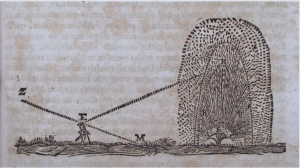
The rainbow fountain demystified by Descartes in the 17th century.
In Encyclopedia of the Exquisite I write about maraviglia, the marvels that 16th century and early 17th century European princelings expected from the artists they hired in order to keep themselves amused. Chief among these marvels were giochi d’acqua, or “water jokes,” which are also in the book, and which clever garden engineers installed in elaborate Renaissance gardens. In those days, nothing amused the de Medicis more than seeing their guests bumble though a garden full of giochi d’acqua, hydraulically powered pranks, like hidden pressure-triggered spouts that left the unsuspecting visitors drenched. But the wonders of these gardens—especially hydraulically powered automata, statues which came to life in the middle of the fountains—were truly fantastic.
If there was one man who refused to be taken in by it all, however, it was Descartes. In 1629 he began a methodical investigation of the rainbow fountain, a popular feature in many ritzy gardens of the era. The device sprayed a thin mist of water into the air, and, when viewed at the right angle, the sun shining through the droplets created a rainbow in the air. Ta-da! While everyone else was happy to marvel at the pretty rainbow, Descartes was unsatisfied. Why, he asked, should we marvel at the work of craftsmen when the laws of natural philosophy—the mathematical principles of reflection and refraction—are so much more beautiful? So, with an essay entitled De l’arc-en-ciel, Descartes kicked off a centuries long push towards rationality and reverence for scientific thought. He disclosed all the garden designers’ secrets. Light, when refracted through waterdrops at a certain angle—between around 41 degrees and 51 degrees—made rainbows. Engineers did not.

Rainbows were well understood by the 18th century.
Descartes predecessors thought that in order to be enjoyed, the mechanisms behind the rainbow fountain needed to remain mysterious. As one scholar explained, “to give a greater grace to the practice of things, they ought to be concealed, for that which doth ravish the spirits is an admirable effect, whose cause is unknowne.” Descartes allowed that wonder was what drew us to the noble, and in his Passions de l’ame (“Passions of the Soul”) he praised wonder as first among the passions for “making us learn and hold in memory things we have previously been ignorant of.”
But from that point on the natural philosophers looked at nature as a series of special effects. Their contemporary, Fontenelle, described these men like Descartes: they made unveiling nature’s backstage tricks their work, and by doing so offered the world a different sort of wonder. What was better, marveling at the rainbow fountain or at the mathematical principles behind its creation?



What is the source of the second image? Is it also from Descartes?
Dear Ann,
Thanks for writing. That is a very pretty 18th century image that I found–no idea where!
All best,
Jessica